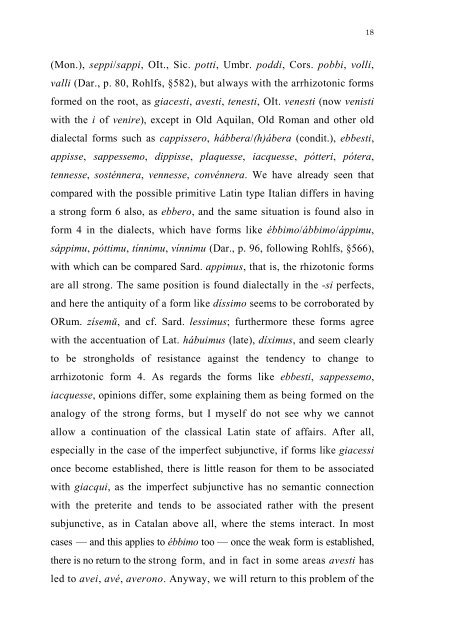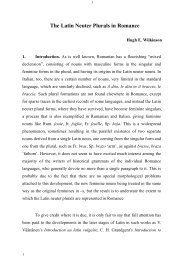THE STRONG PERFECTS IN THE ROMANCE ... - Page ON
THE STRONG PERFECTS IN THE ROMANCE ... - Page ON
THE STRONG PERFECTS IN THE ROMANCE ... - Page ON
You also want an ePaper? Increase the reach of your titles
YUMPU automatically turns print PDFs into web optimized ePapers that Google loves.
(Mon.), seppi/sappi, OIt., Sic. potti, Umbr. poddi, Cors. pobbi, volli,<br />
valli (Dar., p. 80, Rohlfs, §582), but always with the arrhizotonic forms<br />
formed on the root, as giacesti, avesti, tenesti, OIt. venesti (now venisti<br />
with the i of venire), except in Old Aquilan, Old Roman and other old<br />
dialectal forms such as cappissero, hábbera/(h)ábera (condit.), ebbesti,<br />
appisse, sappessemo, dippisse, plaquesse, iacquesse, pótteri, pótera,<br />
tennesse, sosténnera, vennesse, convénnera. We have already seen that<br />
compared with the possible primitive Latin type Italian differs in having<br />
a strong form 6 also, as ebbero, and the same situation is found also in<br />
form 4 in the dialects, which have forms like ébbimo/ábbimo/áppimu,<br />
sáppimu, póttimu, tínnimu, vínnimu (Dar., p. 96, following Rohlfs, §566),<br />
with which can be compared Sard. appimus, that is, the rhizotonic forms<br />
are all strong. The same position is found dialectally in the -si perfects,<br />
and here the antiquity of a form like díssimo seems to be corroborated by<br />
ORum. zísemŭ, and cf. Sard. lessimus; furthermore these forms agree<br />
with the accentuation of Lat. hábuimus (late), díximus, and seem clearly<br />
to be strongholds of resistance against the tendency to change to<br />
arrhizotonic form 4. As regards the forms like ebbesti, sappessemo,<br />
iacquesse, opinions differ, some explaining them as being formed on the<br />
analogy of the strong forms, but I myself do not see why we cannot<br />
allow a continuation of the classical Latin state of affairs. After all,<br />
especially in the case of the imperfect subjunctive, if forms like giacessi<br />
once become established, there is little reason for them to be associated<br />
with giacqui, as the imperfect subjunctive has no semantic connection<br />
with the preterite and tends to be associated rather with the present<br />
subjunctive, as in Catalan above all, where the stems interact. In most<br />
cases — and this applies to ébbimo too — once the weak form is established,<br />
there is no return to the strong form, and in fact in some areas avesti has<br />
led to avei, avé, averono. Anyway, we will return to this problem of the<br />
18









